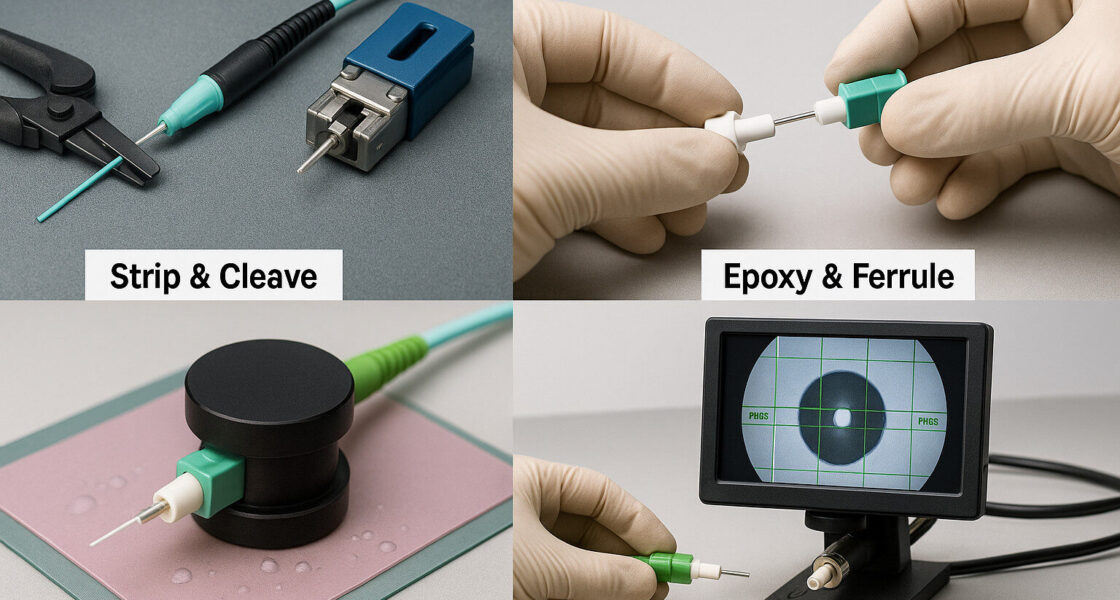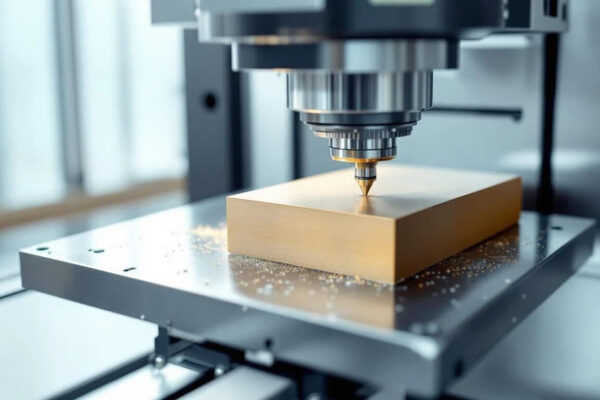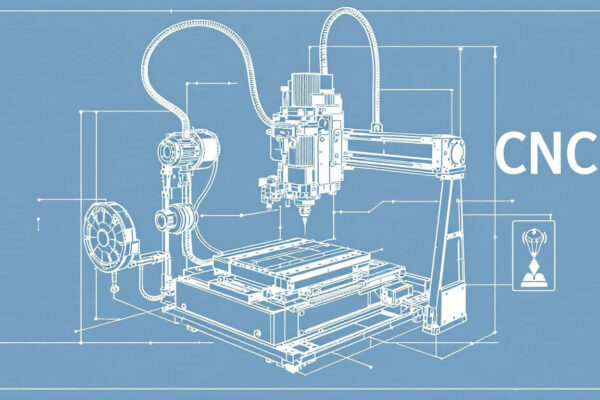Key Takeaways
- Fiber optic cable assembly quality hinges on selecting the right connector type—most commonly LC, SC, or ST—to match device ports and installation environment.
- LC connectors dominate high-density panels and modern transceivers (SFP/SFP+, QSFP), while SC remains common in enterprise and FTTH; ST appears mainly in legacy and industrial installations.
- Polish type (UPC/APC), fiber mode (OS2 single-mode, OM3/OM4/OM5 multimode), and cable geometry (simplex/duplex, 0.9/2.0/3.0 mm) directly influence insertion loss and return loss.
- “OFC connector type” is often used informally to mean optical fiber connector type and typically refers to LC, SC, ST, FC, MPO/MTP and others—choose based on device interface and optical budget.
- Structured inspection (end-face microscopy), testing (IL/RL, continuity), and proper cable management reduce failures and speed up commissioning.
- Getting connector selection right from the start saves time in the field and helps avoid unexplained dB losses later.
This guide explains the most commonly used fiber connectors—LC, SC, and ST—and shows how they fit into modern optics and fiber optic cable assembly workflows.

What Is a Fiber Optic Cable Assembly?
A fiber optic cable assembly is a pre-terminated optical cable—cut to length, jacketed, labeled, and tested—with a defined connector type on each end.
Typical builds include LC-LC, SC-SC, LC-SC, or ST-ST jumpers, plus hybrid cords for media converters and test equipment.
Assemblies are specified by:
- Fiber mode (OS2 single-mode; OM3/OM4/OM5 multimode)
- Polish (UPC/APC)
- Strand count (simplex/duplex)
- Cordage diameter
- Environmental and fire rating (e.g., LSZH, indoor/outdoor, armored)
Fiber Connector Types You’ll Use Most
LC Connector (High-Density Applications)
The LC connector uses a 1.25 mm ferrule and a push-pull latch, enabling very high port density on modern patch panels and transceiver cages.
LC is the de facto standard for SFP/SFP+ and QSFP breakout connections because it supports duplex channels in a compact footprint without compromising handling.
LC-APC variants are common in PON backbones and test leads where very high return loss performance is required.

SC Connector (SC Fiber Jumpers)
The SC connector features a 2.5 mm ferrule and a square snap-in housing that locks securely into adapter panels.
It is widely used in enterprise networks, FTTH, and CATV.
“SC fiber” or “SC connector fiber” patch cords are simply SC-terminated jumpers in single-mode or multimode, available with UPC (blue) or APC (green) polish.

ST Connector
It is frequently found in legacy industrial and campus networks. While less common in new high-density systems, it remains important for maintaining existing infrastructure and for test equipment equipped with ST ports.

“OFC Connector Type” Explained
In many procurement specifications, “OFC connector type” is shorthand for the required optical fiber connector on the cable ends.
Common choices include LC, SC, ST, FC, and MPO/MTP.
When selecting the OFC connector type, align with:
- Device ports and panel adapters
- Fiber mode and polish
- Link budget (loss, reflectance) and length
If a datasheet is ambiguous, verify whether “OFC” refers to an optical fiber connector or to oxygen-free copper (also OFC), particularly in audio or power cabling contexts.
| Connector | Ferrule | Latch Style | Typical Use | Polish |
|---|---|---|---|---|
| LC | 1.25 mm | Push-pull | Switches, SFP/QSFP transceivers, high-density panels | UPC/APC |
| SC | 2.5 mm | Snap-in | Enterprise/FTTH/CATV panels and CPE | UPC/APC |
| ST | 2.5 mm | Bayonet | Legacy/industrial/test gear | UPC |
| MPO/MTP | Multi-fiber | Push-pull | High-count trunks, leaf-spine backbones | Flat/angled |

Where Connectors Meet Transceivers
Most pluggable transceivers are tied to specific connector families:
- SFP/SFP+ and QSFP modules typically present LC duplex interfaces.
- Many PON OLT/ONT ports use SC-APC.
- Some test sets still ship with ST ports.
Before ordering, check the module faceplate and specify fiber optic assemblies with matching connector types and polish.

Specifying a Reliable Assembly
- Mode & bandwidth:
- OS2 for long-haul and single-wavelength links
- OM4/OM5 for short-reach, high-speed parallel optics
- Polish:
- APC (angled) for PON/backbone and reflection-sensitive links
- UPC for most duplex point-to-point connections
- Always match polish types at both ends
- Geometry:
- Simplex or duplex
- 0.9 / 2.0 / 3.0 mm cordage
- Indoor, LSZH, outdoor, or armored as required
- Environment:
- Rack density, bend radius, routing space, and pull strength
- Consider uniboot LC in high-density environments
- Documentation:
- Request IL/RL test reports, end-face images, and serial-level labeling

Testing & Quality Control
Each fiber optic cable assembly should be verified with:
- Insertion loss (IL) and return loss (RL) measurements
- End-face inspection (per IEC standards) to confirm no scratches, pits, chips, or contamination on LC/SC/ST ferrules
Field acceptance and troubleshooting are significantly faster when:
- Factory test reports are supplied per assembly, and
- Labels clearly map to rack, panel, and port IDs.

Quick Buyer’s Checklist
- Confirm device ports and OFC connector type (LC, SC, ST, etc.).
- Match polish (UPC/APC) and mode (OS2/OM4/OM5) to the link design.
- Specify length, jacket rating, and simplex/duplex configuration.
- Request test data and end-face images for each assembly.
- Plan bend radius, routing, and labeling for panels and transceivers.
Frequently Asked Questions
Q1. Which connector is best for dense switches?
A: The LC connector is optimized for high port density and is compatible with most SFP/SFP+ and QSFP optics. Uniboot LC variants further reduce congestion.
Q2. We have SC fiber jumpers on site—can we mix them with LC?
A: Yes. Use LC-to-SC hybrid assemblies or adapter couplers. Ensure polish types are consistent (UPC ↔ UPC, APC ↔ APC).
Q3. Do ST connectors still make sense?
A: Yes, where existing equipment exposes ST ports (legacy or industrial sites). For new builds, LC is usually the preferred choice unless specific mechanical or environmental constraints apply.
Q4. What does “OFC connector type” mean on a PO?
A: It typically refers to the required optical fiber connector type (e.g., LC, SC, ST). If unclear, confirm against the equipment documentation.
Q5. How do transceivers influence connector choice?
A: Most data center transceivers use LC; MPO/MTP is used for high-fiber-count parallel optics; some FTTH and access devices require SC-APC.
Fiber Optic Cable Assemblies from TPS Elektronik
TPS Elektronik manufactures custom fiber optic cable assemblies—LC, SC, ST, and mixed configurations—with documented IL/RL testing and end-face inspection for each build.
Provide your required connector types, optical budget, and lengths, and we will support you with assemblies engineered for reliable installation and operation.




